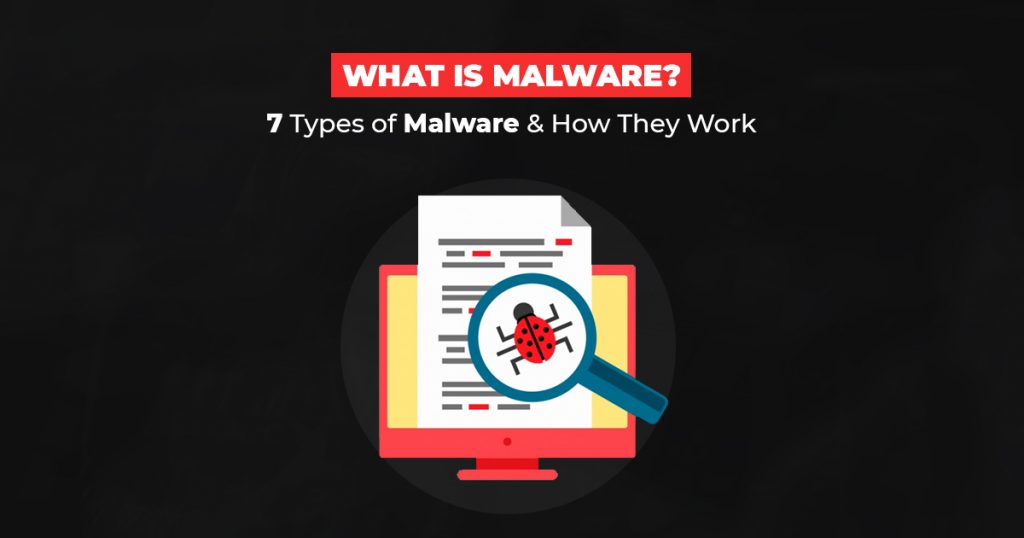Malware, being one of the basic reasons for information breaches, is something each IT and security specialists ought to be worried about. Many organizations will install anti-virus and forget about it, not realizing that malware can at still by-pass anti-virus software and firewalls and there are different types of Malware.
Truly, no anti-virus or anti-malware will shield you from ALL malware. If a virus sneaks through, it implies that your classified data is put in danger.
So, it’s imperative to know the various sorts of malware and how to forestall them. Continue perusing to find out additional information.
What is malware?
Malware is an umbrella term for any piece of software that has malevolent intent. There are some types of malware and every one of them has an exceptional method of penetrating your PC which may incorporate trials at attaining with PC systems, stealing data, scrambling your significant records, or making other damage to your PCs. Now and then the harm can be unavoidable.
Where does malware originate from?
Probably the most well-known resource of malware are email connections, malevolent sites, torrents, and shared networks
Phishing – Emails can be masked to be originating from a deceitful company for the only reason behind to uncover individual data
Malicious Websites– Some sites may endeavor to introduce malware onto your PC, ordinarily through popups or malignant connections
Torrents –Files shared through BitTorrents are commonly risky because no one can tell what to expect until they’re downloaded
Shared Networks –A malware-infected PC on the same shared network may spread malware onto your PC
How Do TLS and SSL Work to Secure Data?
Here’s the high-level technique for how each SSL and TLS work.
When you set up an SSL/TLS certificates on your web server (often simply known as an “SSL certificate), it consists of a public key and a private key that authenticate your server and let your server encrypt and decrypt data.
When a visitor goes to your site, their internet browser will look for your site’s SSL/TLS certificate. Then, the browser will operate a “handshake” to check the validity of your certificates and authenticate your server.
Once a visitor’s browser determines that your certificates is legitimate and authenticates your server, it essentially creates an encrypted hyperlink between it and your server to securely transport data.
This is additionally the place HTTPS comes in (HTTPS stands for “HTTP over SSL/TLS”).
HTTP, and the more current HTTP/2, are application protocols that play a vital position in transferring statistics over the Internet.
With undeniable HTTP, the fact is that it is prone to attacks. But when you use HTTP over SSL and TLS (HTTPS), you encrypt and authenticate at some stage while transferring, which makes it secure.
This is why you can safely process credit card details over HTTPS however now not over HTTP, and additionally why Google Chrome is pushing so challenging for HTTPS adoption.
TLS is the more latest version of Thawte SSL Webserver EV and that each public releases of SSL have been deprecated for a couple of years and include documented security vulnerabilities.
That may have you wondering: why is it known as an SSL certificates and no longer a TLS certificate? After all, TLS is the modern, safety protocol. Most people refer to SSL certificate as essentially a branding issue. Most principal certificates vendors nevertheless refer to certificates as SSL certificates, which is why the naming convention persists.
That is, you can use anyone from the Sectigo SSL Wildcard and TLS protocols with your certificate.
There are many types of Malware but following are 7 Common Types of Malware
Several experts have written on types of Malware on the web but we are explaining it simply. Here’s a list of the regular types of malware and their noxious intent:
1. Trojans
A Trojan (or Trojan Horse) masks itself as real software to fool you into executing vindictive programming on your PC.
2. Spyware
Spyware attacks your PC and endeavors to steal your data, for example, Visa or banking data, web perusing information, and passwords to different accounts.
3. Adware
Adware is an undesirable software that shows ads on your screen. It gathers individual data from you to serve you with more customized promotions.
4. Rootkits
Rootkits enable unapproved clients to access your PC without being detected.
5. Ransomware
Ransomware is intended to scramble your records and block access to them until a ransom is paid.
6. Worms
A worm reproduces itself by infecting different PCs that are on a similar network.
7. Keyloggers
Keyloggers monitor your keystrokes on your keyboard and record them on a log.
Instructions to forestall malware
Since malware is so far-reaching and countless new pernicious files are accounted for each year, there’s no single arrangement that will forestall all malware. Consequently, we prescribe utilizing different solutions to add more layers of protection to your PCs.
Use Software
Here is some malware prevention software we suggest:
BitDefender – BitDefender is a balanced solution that secures more than 500 million clients around the world. It offers unparalleled endpoint security and virus protection.
Malwarebytes – The best and broadly adopted anti-malware available. The outputs are exhaustive and the program keeps you from executing malevolent records and visiting vindictive sites.
e Cautious
A little mindfulness and alert can likewise forestall malware from tainting your PC. Here are a few hints:
- If an email looks dubious or unrealistic, don’t open it
- Don’t download records from non-trustworthy sites as they could contain malevolent documents
- Don’t utilize your work PC on open systems
- Extra Tip: Always back up your records!
By now you must have comprehended well about types of malware. As referenced before in this article, now and again malware can cause unalterable harm —, for example, record encryption and data loss. To spare yourself from a ton of difficulty, it’s critical to keep your records backed up so you can reestablish them if something like this occurs.

